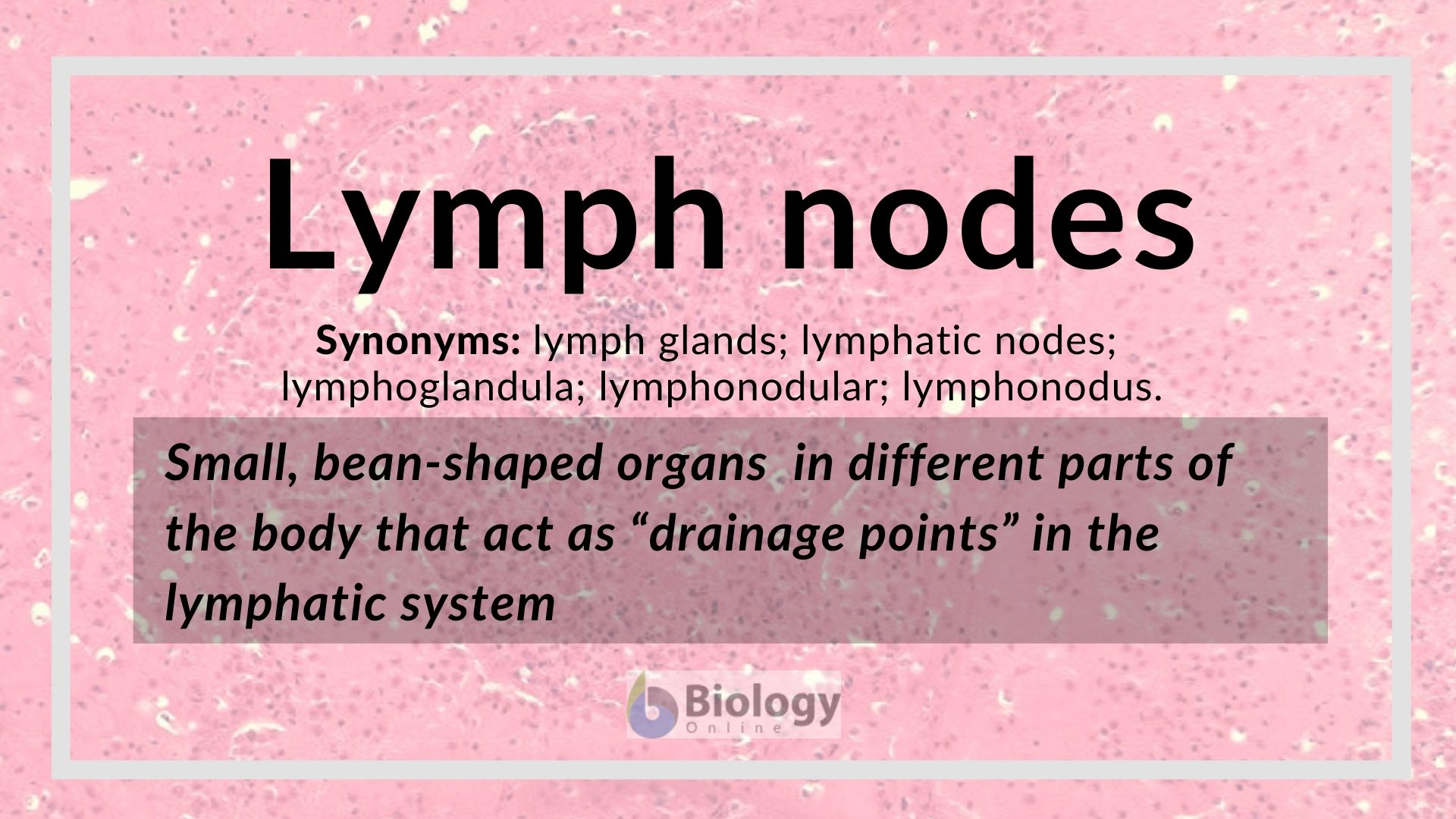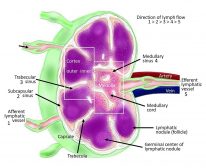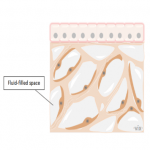
Definition of lymph nodes
Table of Contents
Lymph nodes definition
Lymph nodes are small, bean-shaped organs located in different parts of the body and act as “drainage points” throughout the lymphatic system. They store special cells (lymphocytes) that can trap cancer cells and bacteria traveling through the body in lymph. Each lymph node is an organized structure surrounded by a fibrous capsule and a substance of three major regions: (1) cortical, (2) paracortical, and (3) medullary. Lymph enters the lymph nodes at intervals in the lymphatic system to be filtered out of bacteria, antigens, and cancer cells prior to returning to the bloodstream. The human body has several lymph nodes that occur in clusters. They are located in the cephalic (mostly), thoracic, and inguinal regions. Etymology: from Latin lympha , meaning “water”, “water nymph”; Latin nodus, meaning “a knot”. Synonyms: lymph glands; lymphatic nodes; lymphoglandula; lymphonodular; lymphonodus.
Are lymph glands and nodes the same thing?
Lymph nodes are also referred to as lymph glands because they seem like a true gland. However, lymph nodes are not precisely glands. A true gland is defined as an infolding of an epithelial sheet specialized for secretion. Lymph nodes are masses of tissues in the lymphatic vessels where several immune cells are located. They are not mainly for secretion but to serve as filters of the body. The lymph passes through these “checkpoints” to be filtered for cells and other particles (antigens) designated for destruction.
Lymph node structure
A lymph node is a mass of tissue encased by a fibrous capsule, with a shape resembling a “bean”. The capsule is made up of reticular fibers of reticular connective tissue. It extends to the inside of the lymph node. These capsular extensions are referred to as “trabeculae” (singular: trabecula). Lymph nodes have substances, each consisting of three major tissue regions: (1) the cortical region (cortex), (2) the paracortical region (paracortex ), and (3) the medullary region (medulla). (Ref.1) These regions are made up of connective tissues wherein immune cells are enmeshed. The outermost region is the cortex whereas the innermost, the medulla. The paracortex surrounds the medulla. The presence of trabeculae divides these regions into lobules (also called nodules). The cortex contains the lymphoid follicles (i.e. masses of lymphoid tissue) that may be primary or secondary. The primary follicles contain mostly immature lymphocytes. The secondary follicles contain many B lymphocytes from the bloodstream that have entered the lymph node through the high endothelial venules in the paracortical region. The paracortex is the tissue region dominated mostly by mature T lymphocytes and dendritic cells. The high endothelial venules in this region also allows the entry of growth and regulatory factors for the maturation and the activation of the immune cells. (Ref.2) The medulla is largely composed of blood vessels, medullary sinuses, and the medullary cords. The medullary cords are a source of plasma cells. (Ref.1) The medulla also contains the macrophages, such as histiocytes (immobile macrophages), and reticular cells. A depression on the surface of the lymph node through which the efferent lymph vessel emerges from and the blood vessels enter and leave is referred to as “hilum”. The presence of the hilum makes the lymph node shaped like a “bean”.
To identify the different parts of the lymph node see the lymph node anatomy and histology diagram below. Also shown in the diagram is the direction of the lymph flow. Lymph enters the lymph node via the afferent lymphatic vessel. Next, it percolates through the substance of the lymph node through lymph node sinuses. In particular, it moves through a series of sinuses as follows: subcapsular sinus > trabecular sinuses > medullary sinuses. Lymph, then, leaves the lymph node via the efferent lymphatic vessel.

Lymph nodes function
The primary function of the lymph nodes is to filter out lymph that enters the lymphatic system. They remove bacteria and antigens from it. After this, lymph returns to the bloodstream. In the lymphatic system, the lymph nodes, together with the spleen, are its secondary lymphoid organs (SLO). Their role, which is to initiate an adaptive immune response, makes them a part of the immune system as well. In particular, B and T lymphocytes in the lymph nodes are involved in antibody responses and cell-mediated immune responses, respectively. The spleen, though, filters not the lymph but the blood cells.
The lymph nodes also act as the site where lymphocytes can be produced. Aside from the lymphocytes coming from the bloodstream, new lymphocytes are also produced within the lymph nodes. Thus, the lymph nodes can also be a source of lymphocytes apart from other organs of lymphoid tissues, such as spleen, thymus, and bone marrow.
Location of lymph nodes in the body
Lymph nodes, together with the lymph vessels, lymphoid tissues (organs), and lymph, comprise the lymphatic system. The human body typically has about 500 to 600 lymph nodes. They occur as clusters, such as the nodes under jaw (chin), in the neck area, thorax, underarm, and inguinal regions (groin). Based on their location, the lymph nodes are typified and named as follows:
Near or at the chin:
- Mastoid lymph nodes
- Occipital lymph nodes
- Parotid lymph nodes
Near or at the neck area:
- Deep anterior cervical lymph nodes
- Deep lateral cervical lymph nodes
- Jugulodigastric lymph node
- Jugulo-omohyoid lymph node
- Submandibular lymph nodes
- Submental lymph nodes
- Virchow’s node
At the thoracic region:
- Pulmonary lymph nodes: subsegmental lymph nodes, segmental lymph nodes, lobar lymph nodes, interlobar lymph nodes, and hilar lymph nodes
- Mediastinal lymph nodes: tracheal lymph nodes, esophageal lymph nodes, etc.
At the upper limbs:
- Superficial lymph nodes: supratrochlear nodes, deltoideopectoral nodes
- Deep lymph nodes: lateral nodes, anterior nodes, central nodes, and medial nodes
At the lower limbs:
- Superficial inguinal lymph nodes
- Deep inguinal lymph nodes
- Popliteal lymph nodes
Swollen lymph nodes
During an infection, the immune cells in the lymph nodes multiply rapidly. Enlarged or swollen lymph nodes indicate heightened immune activity and the medical condition is referred to as lymphadenopathy. Other possible causes include autoimmune diseases, tumors, cancers, and drug reactions. Thus, treatment varies according to the cause of the enlargement. Swollen lymph nodes caused by infections and allergies are typically painful and reverts to normal size after the infection. Enlarged lymph nodes due to cancer are often painless and may be accompanied by other symptoms, depending on the clinical stage of the cancer.
Swollen lymph nodes armpit
Swollen axillary lymph nodes are common. They are usually caused by infections (bacterial, viral, or fungal). They can also be a manifestation of allergic reactions to chemicals, such as deodorants and antiperspirants. Swollen lymph nodes due to Infections and allergic reactions are often painful. When caused by infection, the condition may be accompanied by fever and swelling of the other lymph nodes.
Swollen lymph nodes in neck
Lymph nodes at the cervical region enlarge as the body fights off an infection. Common causes are ear infections, dental infections, tonsillitis, strep throat infection, and mumps. They are considered swollen when they are larger than 1 to 2 cm in size. (Ref.3)
Swollen lymph nodes in groin
Inguinal lymph nodes become swollen typically because of infection or injury at the lower body. Common examples are athlete’s foot, jock itch, genital infections, urinary tract infection (UTI), cellulitis, prostatitis, cystitis, and sexually transmitted infections.
Related terms
- Hilar lymph node
- Buccal lymph node
- Pretracheal lymph nodes
See also
- Lymphatic system
- Immune system
References
- medullary cords. (n.d.). Retrieved from http://www.dentaldecks.com/wp-content/public/docs/15-16%20as%20card%205%20for%20web.pdf
- Kaldjian, E. P., Gretz, J. E., Anderson, A. O., Shi, Y., & Shaw, S. (2001). Spatial and molecular organization of lymph node T cell cortex: a labyrinthine cavity bounded by an epithelium-like monolayer of fibroblastic reticular cells anchored to basement membrane-like extracellular matrix. International Immunology, 13(10), 1243–1253. https://doi.org/10.1093/intimm/13.10.1243
- Kinman, T. (2012, July 19). What’s Causing This Lump on My Neck? Healthline; Healthline Media. https://www.healthline.com/health/neck-lump#pictures-of-neck-lumps
©BiologyOnline. Content provided and moderated by BiologyOnline Editors.


